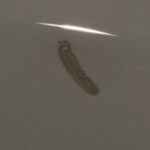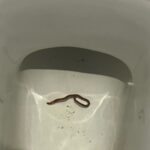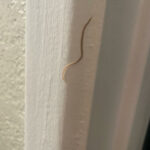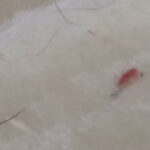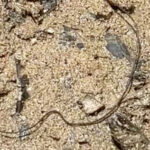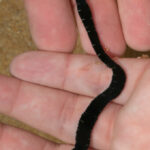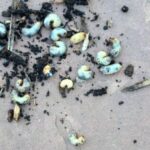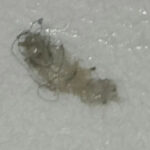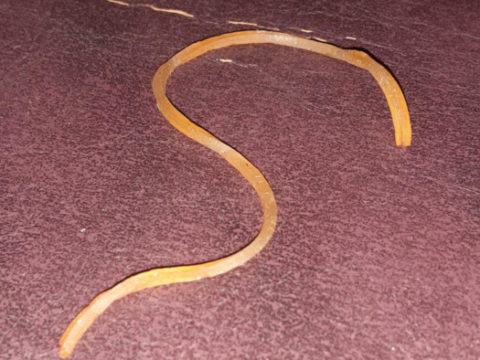
“I’m based in the UK and found this in my bathroom”, writes Angela in her submission regarding the grayish, ovate creature pictured below. “I’ve found three so far and cannot find out what it is. My bathroom has a ledge away from the water source; one was found wiggling on the tiled ledge, and one was in an even more curious location: inside a clean container with some serialized items. The one pictured came from a plastic tray which I was cleaning out and, to be fair, this tray was quite dirty and had a pattern with ridges. It was about 4mm in length and didn’t appear to mind water. Is it a drain fly larva? I’ve posted how it moved on Reddit, linked below. Many thanks!” To start with, we have linked the video below that she posted on Reddit, and it is quite an interesting video. It looks like the organism is underwater, and yet the way it contracts its body and moves forward looks like it is dragging itself across a solid surface, rather than swimming.
Regardless, we think this creature looks most like a bristle worm. In short, a bristle worm is an aquatic worm with bristles (often toxic ones) that belongs to the same phylum of worms as earthworms and leeches. Like earthworms, bristle worms’ bodies are made up of many segments. The bristles grow in pairs at each segment, much like a centipede’s legs grow at each of their segments (though centipedes are not annelids: they are not worms at all). Given the size of this critter, we would say it is likely a larva. During our search for the worm that Angela found, we came upon the sea mouse, which is a genus of bristle worm that is quite furry-looking (hence the name), and is ovate in shape. It resembled the creature Angela found to some degree, so it could be that she found a sea mouse larva.
With all of that said, while bristle worms do live on the coasts of the United Kingdom, they are not even commonly found on the beaches of the UK, much less in people’s bathrooms, so we are not convinced of the plausibility of finding bristle worm larvae in one’s bathroom. That goes for most countries, as bristle worms are largely salt-water species. What we recommend is that Angela avoid physical contact in the case that these are bristle worm larvae (as the bristles could cause an allergic reaction), and that she move any larvae outside by scooping them onto something else (like a dustpan). Similarly, we suggest she do a deep clean of her bathroom and make sure that she consistently clean her drains, to avoid the build-up or organic materials which could attract organisms like the one she found. Bristle worms feed on algae, plankton, and other organic growths that form in stagnant, unclean water.
To conclude, the creatures Angela found in her bathroom look like sea mouse larvae, though we do not know how feasible it is that they would have ended up in her bathroom. They are likely something else that we have never seen before. We hope nonetheless that we provided some useful information and/or advice, and we wish Angela the very best.
All About Worms is always free, always reader-supported. Your tips via CashApp, Venmo, or Paypal are appreciated! Receipts will come from ISIPP Publishing.
You might also find these guys interesting!




